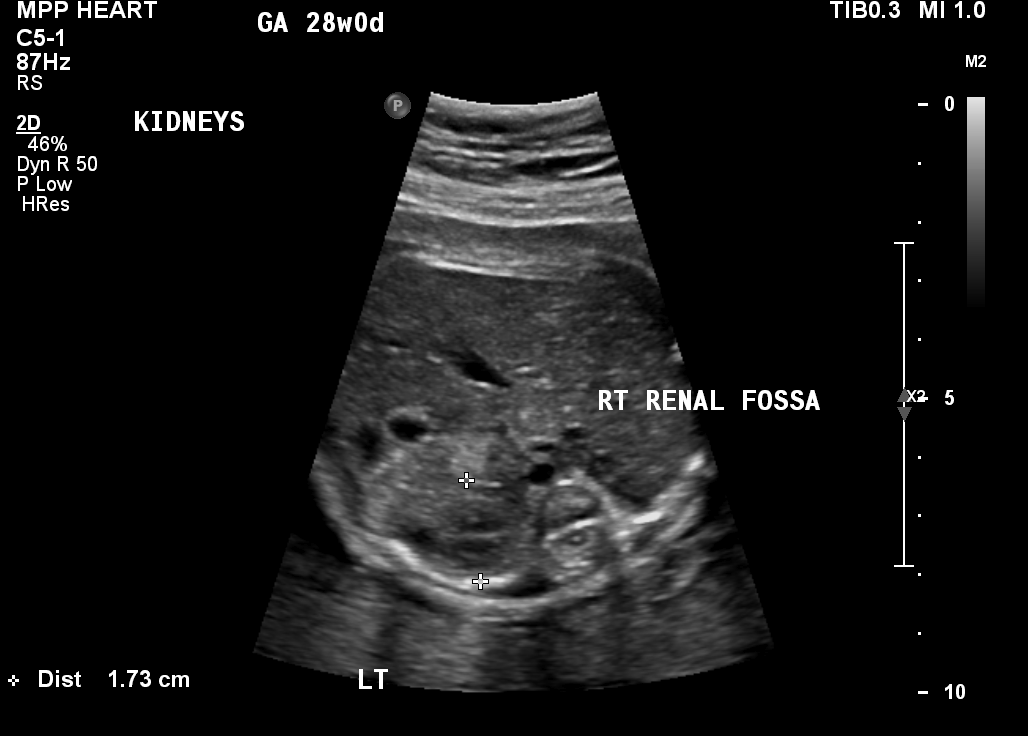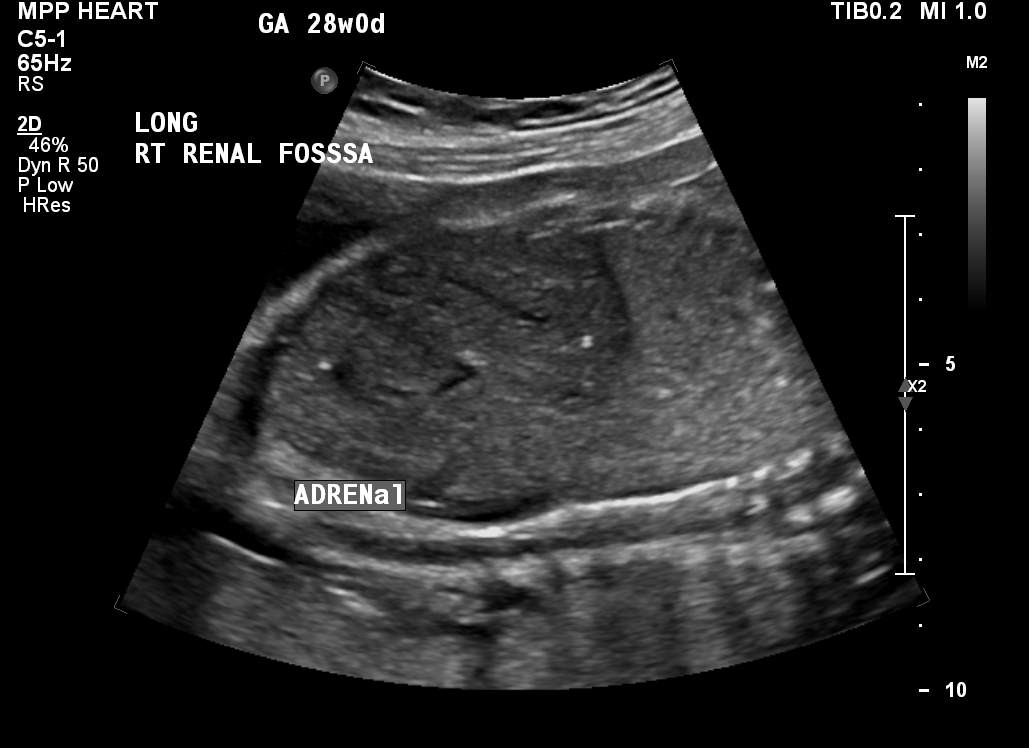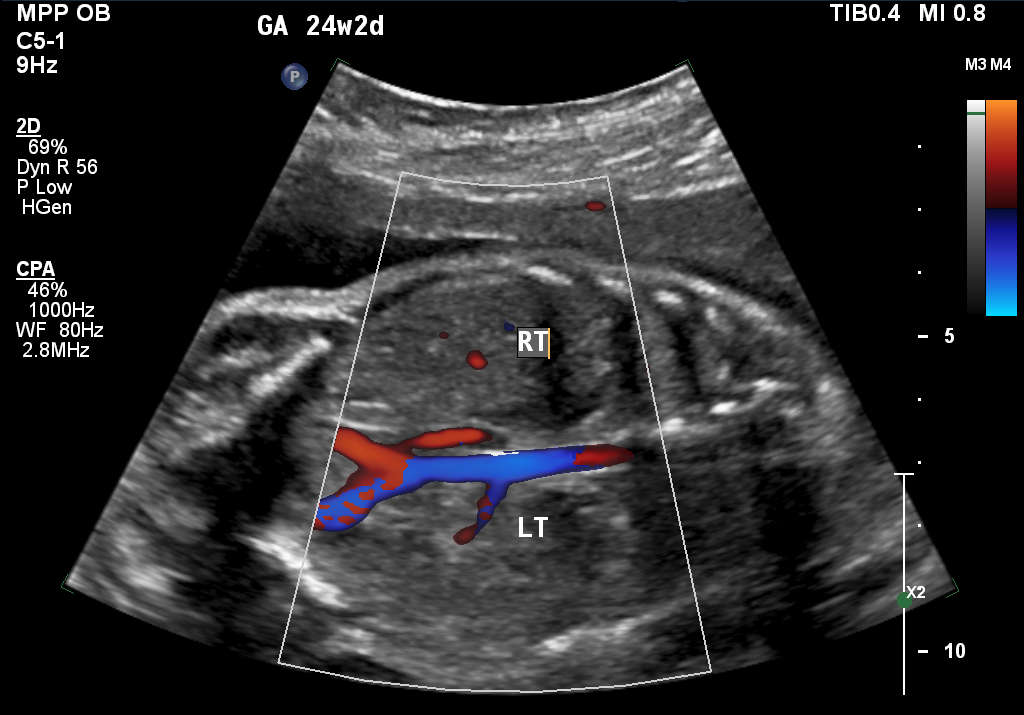Baby That Develop With No Kidneys or Bladder
What is renal agenesis?
Renal agenesis (REE-nall ay-JEN-eh-sister) is a condition in which i or both kidneys neglect to form while a babe is developing in the womb. When only one kidney forms, the condition is known as unilateral renal agenesis. When neither kidney forms, it's known as bilateral renal agenesis. Unilateral renal agenesis occurs in about ane in 2,000 births. Bilateral renal agenesis is more rare, occurring in nigh i in iv,000 births. Both conditions are about three times more common among boys than amid girls.
Kidneys grade betwixt the fifth and 12th week of pregnancy, and begin producing urine by the 13th week. A babe'due south urine is the major contributor to the amount of protective liquid—amniotic fluid—that surrounds the infant in the womb (Effigy one). In addition to containing of import nutrients, hormones, and antibodies, amniotic fluid plays a crucial role in all aspects of the baby's evolution, peculiarly lung development.
As long equally there is a unmarried healthy kidney with normal amniotic fluid volume, babies built-in with unilateral renal agenesis generally have no health issues. In near 50 percent of cases, however, the status is accompanied by additional nascence defects. These defects most unremarkably involve the urinary arrangement, the genitals, the heart, and the primal nervous system (the brain and spinal string).
Babies with bilateral renal agenesis who receive no medical intervention before nativity do non usually survive. They are either born stillborn or die shortly after nascence, primarily because their lungs have failed to fully develop. A clinical trial involving an experimental therapy for babies diagnosed with bilateral renal agenesis is currently underway. This trial consists of medical interventions that are performed both before and afterward birth.
Who volition be on my intendance team?
At the Midwest Fetal Care Eye, a collaboration between Children's Minnesota and Allina Health, we specialize in individual attention that starts with y'all having your ain personal care coordinator to help yous navigate your baby's treatment process. We apply a comprehensive team arroyo to renal agenesis and any associated conditions. That manner, you are assured of getting the best possible information by some of the most experienced physicians in the state. For renal agenesis, your care team will include an obstetrician or midwife, a maternal-fetal specialist, a pediatric kidney specialist, a neonatologist, a pediatric surgeon, a geneticist, a nurse specialist care coordinator, a perinatal social worker, ultrasonographers, and several other technical specialists. This entire squad volition follow you and your baby closely through the evaluation process, and will be responsible for designing and carrying out your complete care plan.
Run into the team
What causes renal agenesis?
Renal agenesis occurs when two embryonic structures — the ureteric bud and the metanephric blastema — fail to get together to class kidneys during the early weeks of the baby'south development. Scientists aren't ever sure why this failure occurs.
Renal agenesis is commonly not inherited, although certain factor mutations have been identified as being associated with the condition. These mutations can be passed on from either parent.
Some research suggests that environmental factors, such every bit exposures to certain medications or toxins during pregnancy, may play a role in the development of renal agenesis. Studies have likewise found that women who are obese, who smoke, or who potable alcohol during pregnancy (particularly rampage drinking during the 2nd calendar month of pregnancy) may be at increased risk of having a baby with renal agenesis. The mother's use of illicit drugs, such as cocaine, during pregnancy has as well been linked to the condition.
Near cases of renal agenesis, however, are not the result of whatever behaviors of the mother.
How is renal agenesis diagnosed?
Renal agenesis is usually identified during a routine prenatal ultrasound. The initial telltale sign of the condition is an empty space (renal fossa) where the kidney should exist (Figure 2). Too, the adrenal gland — a pyramid-shaped structure usually attached to the elevation of a kidney — will appear apartment on the ultrasound, as if it were "lying down" (Figure 3).
Kidneys can sometimes develop in the wrong place within a baby'south body, a status known as an ectopic kidney. To rule out that possibility, your doctor will perform an ultrasound browse, which uses sound waves to place your baby'southward anatomic structures. Information technology can also mensurate the flow of blood through the baby'south blood vessels. Your medico volition look at the ultrasound images to effort to identify renal (kidney) tissue and renal arteries, which behave blood from the heart to each of the kidneys. The absence of renal tissue, along with the absence of the renal artery on the aforementioned side (Effigy four), confirms the diagnosis of renal agenesis.
If no renal tissue is identified and the ultrasound also shows no amniotic fluid in the womb, the diagnosis is probable to be bilateral renal agenesis. The presence of renal tissue with a lack of fluid could be a sign, however, that the membrane around the amniotic fluid — the amniotic sac — has ruptured. Your doctor volition either ostend or rule out this possibility past performing a pelvic test to look for signs of pooled amniotic fluid in the vagina. Other tests may also exist washed to evaluate for the presence of amniotic fluid, which is commonly not found in the vagina.
How is unilateral renal agenesis managed earlier birth?
If your babe is missing a single kidney, the prenatal care you receive will center on acquiring as much information well-nigh the baby's status as possible then that we tin exist prepared during and after delivery to provide optimal care. That includes collecting information on other possible nascency defects.
Nosotros use several different techniques to get together that information, including high-resolution ultrasonography and fetal echocardiogram. If these tests reveal no birth defects other than the unmarried missing kidney, your babe will not require any special prenatal treatment. An extra ultrasound may be washed in the late 2nd or early third trimester of your pregnancy, only otherwise y'all volition receive routine prenatal care.
What is high-resolution fetal ultrasonography?
Loftier-resolution fetal ultrasonography is a non-invasive test performed past one of our ultrasound specialists. The test uses reflected sound waves to create images of your baby within the womb.
What is fetal echocardiogram?
Fetal echocardiography ("repeat" for short) is performed at our centre by a pediatric cardiologist (a md who specializes in fetal heart abnormalities). This non- invasive, high-resolution ultrasound procedure looks specifically at how the babe'south eye is structured and functioning while in the womb. This test is important considering babies with birth defects are at increased adventure of heart abnormalities.
How is bilateral renal agenesis managed before and after birth?
In that location are no established treatment guidelines, either before or after birth, for babies who are missing both kidneys. Parents of babies with bilateral renal agenesis have the option of not continuing with the pregnancy or, if they wish to continue with the pregnancy, of having their babe receive palliative intendance after birth.
Some babies with the condition may qualify for an experimental handling, known as Renal Anhydramnios Fetal Therapy (RAFT). A clinical trial is currently underway to evaluate whether this intervention tin can meliorate survival. The trial is currently recruiting patients. Its goal is to preserve the role of the baby's lungs before nascence by making a serial of injections of fluid into the amniotic sac to maintain normal fluid volumes. After birth, the baby will likely demand to undergo kidney dialysis. A kidney transplant will likely also be needed at some point during the get-go few years of life.
During the dialysis procedure, a machine will remove waste products and excess fluid from your baby's blood—the chore that kidneys commonly do. During the kidney transplant surgery, a surgeon volition place a kidney from a donor into your baby's abdomen. The kidney will then be attached to nearby blood vessels to enable it to starting time working.
To qualify for a RAFT clinical trial, a baby must have no other serious birth defects, normal genetic testing, and a good run a risk of surviving the treatment. Your infant'southward doctor can counsel you on whether your babe is a candidate for this experimental therapy.
How is renal agenesis managed subsequently birth?
Infants with umilateral renal agenesis tin can be delivered vaginally. Our goal will be to take your baby'south nascence occur as most to your due date as possible.
If at that place are any concerns of associated birth defects, your baby may exist born at The Female parent Baby Center at Abbott Northwestern and Children's Minnesota in Minneapolis or at The Female parent Baby Center at United and Children'due south Minnesota in St. Paul. Children's Minnesota is ane of only a few centers nationwide with a nascency center located inside the hospital complex. This means that your infant will be born just a few feet down the hall from our newborn intensive care unit (NICU). Also, many of the physicians you have already met will be present during or immediately subsequently your baby's birth to assist care for your babe right away.
If your infant has bilateral renal agenesis, we will follow the care plan you fabricated for your babe before the nascency.
How long will my baby exist in the hospital?
Infants with just 1 kidney and no other nascency defects or health issues are likely to be discharged within the normal time frame for newborns. Infants with bilateral renal agenesis who survive to commitment are probable to have a lengthy infirmary stay, whether they are receiving RAFT or not.
What is my baby's prognosis?
The prognosis for babies with unilateral renal agenesis and no other birth defects is excellent. These children can alive normal, healthy lives. Special precautions regarding contact sports may need to be made, however, to protect the unmarried kidney.
People born with one kidney are at increased take chances of developing high blood pressure level and kidney affliction during machismo. Routine screening with a primary care physician tin can help identify these issues early on, yet, to ensure timely and effective treatments.
Will my babe require long-term follow upwardly?
Near babies with unilateral renal agenesis practice not require long-term follow-up care. Such follow-upwardly may exist necessary, even so, for babies with the status who have additional nascence defects. These children may also require surgery and hospitalization to help right these other defects.
Infants with bilateral renal agenesis who survive later receiving RAFT treatment will need long-term medical care and follow-up.
Contact usa
Need a referral or more than data? You or your provider tin attain the Midwest Fetal Care Heart at 855-693-3825.
Source: https://www.childrensmn.org/services/care-specialties-departments/fetal-medicine/conditions-and-services/renal/



0 Response to "Baby That Develop With No Kidneys or Bladder"
Post a Comment